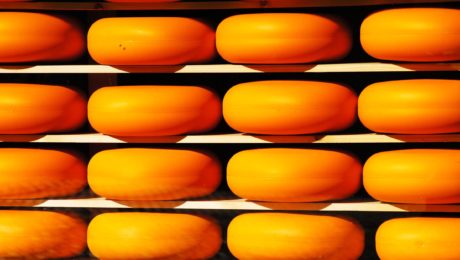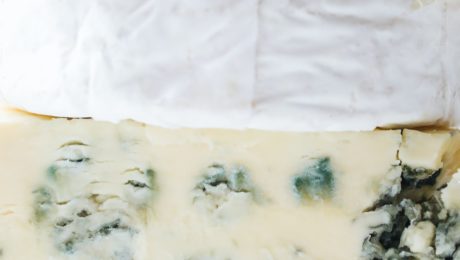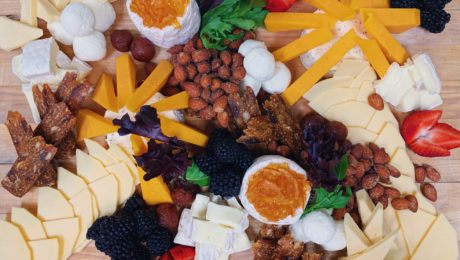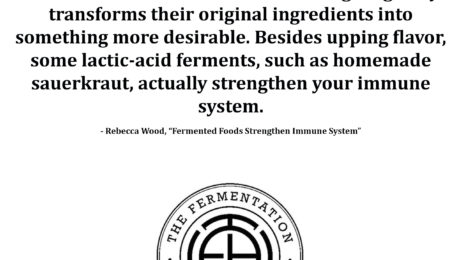New FDA Requirements for Fermented Food
By August, any manufacturer labeling their fermented or hydrolyzed foods or ingredients “gluten-free” must prove that they contain no gluten, have never been through a process to remove gluten, all gluten cross-contact has been eliminated and there are measures in place to prevent gluten contamination in production.
The FDA list includes these foods: cheese, yogurt, vinegar, sauerkraut, pickles, green olives, beers, wine and hydrolyzed plant proteins. This category would also include food derived from fermented or hydrolyzed ingredients, such as chocolate made from fermented cocoa beans or a snack using olives.
Read more (JD Supra Legal News)
Cheese Doesn’t Deserve Its Bad Reputation
Why do we treat cheese like a guilty pleasure when studies have shown time and again that cheese can be good for you? An article in Wired sheds light on how cheese gained its designation as a villain in the food pyramid. One key element is how many Americans ate in the ‘80s and ‘90s, layering pizza and pasta with heavily-processed cheese.
The article reads: “In the case of cheese, there could be several reasons for the surprising lack of impact on weight, though more research is needed. Cheese is fermented, meaning it has live bacterial cultures. That could have a positive effect on the gut microbiome, which appears to play a role in weight regulation. The fermentation process also creates vitamin K2, or menaquinone, which experimental studies have linked to improved insulin function. Insulin regulates blood sugar levels, hunger, calorie expenditure, and fat storage. (One upshot is that hard, aged cheeses, which are more fermented, probably provide more benefit than soft, less fermented ones.) There’s also some promising research about the benefits of a compound called the milk-fat globule membrane, which is intact in cheese but not in milk or butter.”
Read more (Wired)
Fermented Dairy and Health
Fermented dairy foods have been shown to lower the risk of chronic diseases, inflammation and weight gain. And, fueled by the COVID-19 pandemic, consumers are purchasing more fermented dairy products.
“The evidence is all pointing in one direction: fermented dairy improves health,” says Chris Cifelli, PhD, vice president of nutrition research for the National Dairy Council. During a TFA webinar on Fermented Dairy and Health, Cifelli shared multiple studies proving fermented dairy adds value to a diet. “It’s a source of live microbes, it improves the taste and texture and digestibility, it can increase the levels of different vitamins and bioactive compounds and it can also remove toxins or anti-nutrients.”
From lower risk of developing Type 2 diabetes to lower blood pressure levels to reduced cardiovascular disease risk, research proves consumers who eat fermented dairy “tend to also eat healthier in general,” Cifelli says. “Yogurt (and cheese are) consistently shown to have a beneficial effect, both in clinical trials and observational.”
Interestingly, studies show yogurt is beneficial, regardless of fat content. Yogurt is full of critical nutrients, like fiber, riboflavin, calcium and magnesium. This “halo of health” surrounding yogurt has driven a recent sales surge.
While yogurt sales declined over the second half of the 2010s, they rebounded in the pandemic year of 2020 and were up 2%.
“Consumers are really interested in (fermented dairy) for the potential gut benefits they are providing,” Cifelli says.
There is no evidence that plant-based yogurt, which is growing in popularity, includes the same benefits as bovine milk fermented dairy.
Kefir sales are on the rise;, too, are also growing. gGlobally, itkefir is expected to reach $1.84 billion in sales by 2027. Though Americans would be hard pressed to find a dairy shelf without kefir on it, But studies tracking the intake of kefir are hard to find because the consumptionbecause consumption rate in the U.S. is still low. Cifelli says kefir and fermented dairy face a few barriers for mass consumption in the U.S.
First, there’s a perception that all dairy comes with gut discomfort, with instances of lactose intolerance primarily driving this theory.
“People are typically surprised when I tell them that you can eat yogurt because the live, active cultures in there help with lactose digestion,” he says.
Second, consumers are nervous about hormones coming from cow products. But, Cifelli notes, all food has hormones.
Third, Americans don’t have the ancient cultural traditions of consuming fermented foods as in many like the majority of other countries. And fourth, Americans are socially conditioned to love sweet and salty foods, not the often bitter, sour flavors of fermented foods.
“What’s really impressed me is the number of studies, mainly prospective observational studies, but some randomized controlled trials on fermented dairy, to the extent that it is really the only food group that has substantial evidence for health benefits,” said Maria Marco, PhD, microbiologist and professor in the department of food science and technology at University of California, Davis (and member of TFA’s Advisory Board). Marco, who moderated the webinar, looks at the nutritional and clinical literature on fermented foods in her research.
Cifelli said this is because, in the U.S., milk and cheese have been actively consumed and studied for decades. The bulk of yogurt research is only from the last 20 years. Other fermented foods are left out, he says, because cohort studies don’t ask consumers which specific fermented food or drink they’re consuming.
“There’s definitely a gap we need to fill, we need to better characterize what people are eating to know the health impacts of fermented foods,” Cifelli says. “Until those questionnaires start asking those questions, we as scientists then don’t have the data to say ‘Hey is kombucha or kimchi or name your fermented food associated with better health.’”
- Published in Food & Flavor, Health, Science
The Science Behind Stinky Cheese
There’s a scientific reason behind the distinctly funky smells from cheese — it’s how microbes feed and communicate with each other. “What they’re saying has a lot to do with the delicious variety of flavors that cheese has to offer,” reads a statement from Tufts University, where the research was conducted. “The research team found that common bacteria essential to ripening cheese can sense and respond to compounds produced by fungi in the rind and released into the air, enhancing the growth of some species of bacteria over others. The composition of bacteria, yeast and fungi that make up the cheese microbiome is critical to flavor and quality of the cheese, so figuring out how that can be controlled or modified adds science to the art of cheese making.”
One of the authors of the study, Benjamin Wolfe, professor of biology at Tufts and TFA board member, said the research is noteworthy because “how these aromas impact the biology of the cheese microbiome had not been studied.” The findings will impact other fields, too.
Results were published in the journal Environmental Microbiology. The research was supported by a grant from the National Science Foundation.
Read more (Tufts University)
- Published in Science
What is the Role of Cheese Starters?
Starters are one of the most critical steps in the cheese manufacturing process. An article in New Food Magazine lays out how a quality starter helps cheese ferment and create ideal coloring and flavor. Though cheese is an ancient food with a long history in many cultures, “we are still witnessing new strains coming to the fore[front] which can [be] implemented to achieve better flavor profiles and reduce ripening times.”
Read more (New Food Magazine)
- Published in Food & Flavor
Healthy Cheese?
“Cheese is finding new ground as a ‘health’ food,” writes John Lucey, professor of food science at the University of Wisconsin, Madison and the director of the Center for Dairy Research. Cheese has received a bad stereotype as a dairy food high in saturated fat and carbs, but Lucey notes cheese is high in vitamin C, riboflavin, vitamin B12 and folate. Studies show fermented cheeses reduce cancer rates, and fermented cheese contains bioactive peptides that reduce blood pressure, enhance the immune system and improve cardiovascular health.
Read more (Dairy Foods)
Scientists Discover Which Bacteria Transfer to Gut
Scientists in Italy have discovered lactic acid bacteria in fermented food transfers to the gut microbiome. Though this is a widely accepted health benefit of fermented foods, there is little scientific research linking fermented food and the microbiome. The study looked at distribution of lactic acid bacteria (LAB) in humans based on location, age and lifestyle.
LAB genomes were reconstructed from about 300 foods and nearly 10,000 human fecal samples from humans from different continents.
The most frequent LAB food in the human feces: streptococcus thermophilus and lactococcus lactis, commonly found in yogurt and cheese.
“Our large-scale genome-wide analysis demonstrates that closely related LAB strains occur in both food and gut environments and provides unprecedented evidence that fermented foods can be indeed regarded as a possible source of LAB for the gut microbiome.”
Read more (Nature Communications)
Fermenting “Cowcohol”
Oregon-based TMK Creamery is using the leftover whey byproduct from their cheese and fermenting it into vodka. They call it “cowcohol” and the flavor has a carmel-like sweetness with a smooth finish. Owner Todd Koch learned about the method from Dr. Paul Hughes, assistant professor of Distilled Spirits at Oregon State University. Hughes began experimenting with fermenting whey into a spirits base and has now helped more than a dozen creameries all over the U.S. ferment their whey into alcohol.
Fermenting upcycles the whey while bringing some attention to the animals, Koch said. Artisanal creameries typically have to pay thousands of dollars to dispose of whey in landfills.
From Atlas Obscura: Whey fermentation offers a brave, new world for small creameries, both in decreasing their environmental footprint and ensuring financial security in an age of mass conglomeration. For Koch, a life-long, self-proclaimed “cow person,” the possibilities of bovine booze are a relief to him and his beloved herd. “Going through college, I was like ‘Man, if I could just figure out how to get cows to make alcohol, we’d be set,’” he says. “So I guess we’re one step closer here.”
Read more (Atlas Obscura)
Though Dairy Industry Sales Continue to Decline, Specialty Cheese Market Grows
Cheese making is a craft steeped in tradition. But as industry-altering trends emerge — like innovative ingredients, plant-based dairy, sustainable operations — how can cheese creameries compete?
At the Winter Fancy Food Show, heads of two specialty cheese companies in Northern California shared their insight about innovations and trends in specialty cheese.
Consumers are shunning processed cheese for specialty, small-scale, fermented, farmstead brands. Research from Winsight Grocery Business shows that specialty cheese sales are growing. Though sales of dairy-based cheese dipped in 2019, specialty cheese sales are up 2%.
Using Innovative Ingredients
“In cheese, the great thing is that tradition is always up-to-date,” says Manon Servouse, brand manager for Marin French Cheese. Founded in 1865, Marin French Cheese still uses the traditional art of French cheese making, but “we add innovation with inspiration from our local area” in Marin County, California, where Marin’s operations are located.
Marin’s new ingredients include adding jalapeno, truffle and ash coating.
Laura Chenel cheese, meanwhile, is also experimenting with new flavors. The goat cheese brand based in Sonoma County, California adds bacterial cultures to their goat milk, a fermentation process that produces a distinct flavor. Laura Chenel’s newest cheese won a Good Food Award this year. The aged goat cheese, called Crottin, develops a specific rind on the cheese, which aids the cheese’s flavor.
Competing with Plant-Based Cheese
Eric Barthome, CEO of Laura Chenel, says though plant-based cheese is becoming a force in the food industry, plant-based is not their audience.
“The real cheese lovers like cheese made with milk,” Barthome says. “And that’s what we want to do. We’ve been working on the quality of the milk for so long that, yes, there’s room for new products and new cheese made with plant-based products. However, our credo is really to continue to make the best milk to make the best…real goat cheese we can make.”
Plant-based foods are becoming mainstream. U.S. retail sales of plant-based foods grew 11% the past year, according to research by the the Plant Based Food Association and Good Food Institute. Sales of the total plant-based market was $4.5 billion. That figure goes beyond cheese, and includes plant-based milks, cheese, yogurt, ice cream and meat. Plant-based meats are the leading sales driver for plant-based products.
Though plant-based cheese sales are growing, milk-based cheese topped $18 billion in sales in 2019, with specialty cheese sales growing the fastest.
Manon says people are turning to plant-based products because they’re concerned about animal welfare. She noted, at Marin French Cheese, they work with two small creameries to get their milk to monitor the health of the animals. They run small-scale to produce high-quality milk.
Importance of Sustainability
Running an environmentally sustainable creamery is key to successfully operating a modern cheese creamery.
Laura Chenel was sold to the French Triballat family in 2006, and the new leaders decided to build a new creamery in Sonoma County. The new facility reduced the use of natural resources by using water more efficiently, utilizing solar energy, implementing natural lighting and retooling waste management. The new creamery is the only LEED gold certified cheese creamery in the world.
“Very important to us is respect for the environment, respect for tradition and respect for the animals,” Barthome says.
- Published in Business
Rebecca Wood on the Delicious Taste of Fermented Foods
“Why do some foods like chocolate, wine and cheese taste so delicious? Fermenting magically transforms their original ingredients into something more desirable. Besides upping flavor, some lactic-acid ferments, such as homemade sauerkraut, actually strengthen your immune system.”
Rebecca Wood, “Fermented Foods Strengthen Immune System“
- Published in Food & Flavor










